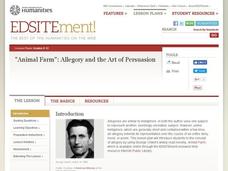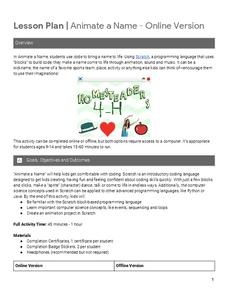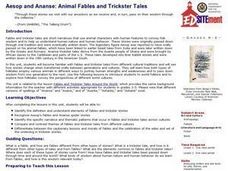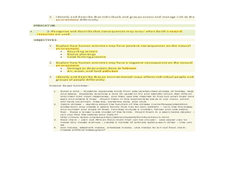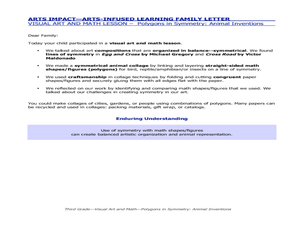Curated OER
Oaxacan Animal Art
Kids of any age can experience the beauty, color, and patterns of Oaxacan art. They view, discuss, and then make their own versions of Oaxacan animal sculptures using sulphite paper. This would be a good follow-up activity to accompany a...
National Endowment for the Humanities
Animal Farm: Allegory and the Art of Persuasion
Introduce your class members to allegory and propaganda with a series of activities designed to accompany a study of George Orwell's Animal Farm. Readers examine the text as an allegory, consider the parallels to collective farms...
EngageNY
Grade 9 ELA Module 3, Unit 1, Lesson 9
Keeping animals relaxed and comfortable has numerous benefits. Explore Temple Grandin's unique perspective on animal behavior with a lesson that concentrates on a central idea within the text. High schoolers prepare for the final...
Curated OER
Animal Masks
Learners create wonderfully animate animal masks out of balloons. They use the papier-mache technique to create three dimensional animal masks taking care to consider color, shape, texture, and the animals' features.
Google
Animate a Name
What's in a name? Pupils use the Scratch code blocks to animate letters in a name. They learn about events, sequencing, and loops in computer science by taking part in the project.
ESL Kid Stuff
Zoo Animals
Let's go to the zoo! Take a pretend trip to the zoo with a lesson plan about animals that live at the zoo. Kids sing, match animals, practice animal sounds, and read about Sammy the Snake's birthday party.
Alliance Theater
The Jungle Book Post-Show STEAM Lesson
An ecosystem is really just the flow of energy through many different living organisms. A study of Rudyard Kipling's The Jungle Book leads to an environmental science activity in which learners study how various factors can affect...
Curated OER
Paper Ring Art
A few bits of paper can really go a long way when it comes to art. Learners build motor skills and a creative voice as they shape and glue thin strips of paper, creating an original scene.
Channel Islands Film
Dark Water: Lesson Plan 2 - Grade 3
A discussion of bioluminescence launches an investigation of animal adaptations. After re-watching the opening minutes of Dark Water, class members listen to a reading of What Do You Do with a Tail Like This, and then create a new...
Curated OER
Aesop and Ananse: Animal Fables and Trickster Tales
Students complete compare and contrast activities dealing with fables and trickster tales to determine how each uses animals to portray human characteristics, specifically strengths and weaknesses, as well as pass wisdom from one...
National Wildlife Federation
Massive Migrations
Turn your students into flocks of migratory birds for this fun lesson on animal migration. Prior to the activity, the teacher creates four different migration routes in the classroom or any available open space, labeling nesting...
Curated OER
Music Lesson Plan for Teaching Children with (Severe) Autism
Here's a packet of music activities designed specifically for children with autism. Kids learn greeting, echo, and repertory songs, as well as rhythmic patterns to play rhythm instruments.
Google
Animation: Studio Logo
Logos just make a club seem more fun. Scholars incorporate knowledge from previous lessons in the unit to write a computer program in the Scratch block-based language. Their program should help design a logo for the CS First studio. A...
Curated OER
Animated Alphabet
Students explore English by completing an interactive language history activity. In this word recognition activity, students discuss word formations and the phonetic relationship between letters. Students identify the origin of...
Curated OER
African Ecology and Art
Explore Samburu culture as learners examine art work by many artists and compare and contrast their styles. They view Kenyan images and find Kenya on the map. Students identify conflict in the animal world and draw animals and record in...
National Gallery of Canada
Artful Emotions
Blue is sad, and red is angry, but why is that? Young artists explore the expression of emotions through art by observing and creating artwork. Starting with a questioning session about images of art, this plan moves into a sculpture...
Curated OER
Language Arts: Scavenger Word Hunt
Participate in a scavenger hunt to find objects beginning with a particular letter sound and take digital photos of them with your scholars. Using software, they find word pictures beginning with particular letters and locate picture...
Curated OER
Track Traces
Learners explore animal characteristics by participating in an animal anatomy activity. In this animal tracks lesson, students identify the differences between specific animals and the shape of their footprints. Learners utilize a...
Curated OER
Exploring Optical Movement in Art
Young scholars describe, represent and analyze patterns and relationships using shapes. They create simple geometric patterns. They demonstrate increasing technical ability and skill to complete visual arts assignments.
Curated OER
Form and Observation
Use a familiar song and adorable baby animal pictures to teach youngsters about genetic variation. Begin by listening to "Twelve Variations on 'Ah vous dirai-je Maman,'" which you will need to find online (there are several versions...
National Gallery of Canada
My Own Blanket
Invite your young artists to design blankets that express their own identities. Learners examine various pieces of art before brainstorming a few things that represent their identities. They use these ideas, in addition to symmetry and...
Curated OER
Polygons in Symmetry: Animal Inventions
Fourth graders use polygons to create animal figures with symmetry. For this polygons and symmetry lesson, 4th graders create a symmetrical animal collage by cutting and gluing geometric shapes and figures from math activities.
Curated OER
Making a Basic Clay Animal Sculpture In-The-Round
Students create a three dimensional animal sculpture. In this sculpting lesson, students use white art clay, gloss glaze, brushes, and wooden tools to create an animal sculpture.
Curated OER
Animals in Art
Second graders demonstrate visual awareness by listing seven to nine types of animals shown in the artwork on the tour. They draw three types of textured lines or patterns shown in the tour artwork and model an imaginary animal using clay.

